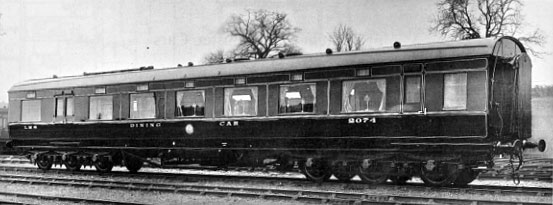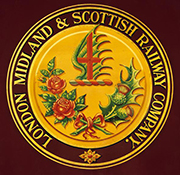

This site uses non-intrusive cookies to enable us to provide a better user experience for our visitors. No personal information is collected or stored from these cookies. The Society's policy is fully explained here. By continuing to use this site you are agreeing to the use of cookies.

LMS Car No 274 of the later Period II cars to D1810.
From almost the very inception of the LMS Railway, the design and building of coaches followed a very standardised pattern. There were very many types of coaches built to suit the various services and needs but, in general, the progression of design features was a logical one and is not unduly difficult to analyse. Three quite distinct periods of design can be recognised, the last of which continued until after nationalisation.
For a number of reasons it is best to consider the coaches around these three periods, and the main features are noted below summarising the main stages of development of gangwayed stock, remembering that non-corridor stock tended to follow similar phases of development.
| Period I | Pre-group traditions still quite strong, generally with MR ideas predominating. Coaches were mostly fully wood panelled and beaded although a few were 'all steel'. Open coaches were of 'two window' style as were the compartment sides of later corridor coaches. The design period culminated with the high waisted single window stock of 1928/9. Coaches built during this period were sometimes referred to as 'Fowler' vehicles. |
| Period II | Single window low waisted designs, initially retaining the exterior wood panelling and beading. The style ended with the gradual change to the exclusive use of exterior steel panels although still with 'square' windows. The coaches were often referred to as 'Lemon' vehicles. |
| Period III | Wooden framed bodies but now with totally flush steel panels, rounded window corners and ribbed roof style. Large windows had sliding ventilators and the styling remained virtually unchanged until after 1947. Often referred to as 'Stanier' stock, the style culminated in the short lived 'Porthole' variation which in its final form helped to pave the way for the BR standard stock. |
The standard LMS underframe was built in a variety of lengths but the vast bulk of designs were made for the 57 ft. length which was the final LNWR standard and was also, latterly, a length which the Caledonian and Midland Railways had used. Regardless of length, all LMS underframes were substantially identical and shared common truss rod dimensions. Longer chassis were adopted for more specialised stock and the following list summarises the principal utilisation of the various lengths, other than the 57 ft. standard variety:
| 69 ft. | Period 111 12 wheel Sleeping Cars. |
| 68 ft. | All Kitchen/Dining Cars and pre-Stanier 12 wheel sleeping cars. |
| 65 ft. | Period III vestibule first dining coaches and third class sleeping cars. |
| 62 ft. | Later versions of Period III corridor brake composites. |
| 60 ft. | Period I third class sleeping cars, Period II vestibule third class dining coaches, most designs of corridor composites and brake composites (except for the earlier Period I all-door designs) and many TPO vehicles. This was the most common alternative length for gangwayed coaches after the 57 ft. variety. |
| 59 ft. | Some electric driving motor coaches. |
| 58 ft. | Some electric multiple unit stock. |
| 54 ft. | Non-corridor stock for the LT & S and Cathcart Circle services plus a few batches for general service. |
| 51 ft. | One batch only of non-corridor composites for the Cathcart Circle services. |
| 50 ft. | Most passenger full brakes and kitchen cars. |
The LMS also built some articulated coaches and for the gangwayed vehicles, Stanier designed a centrally trussed lattice type underframe. This was first tried out as far as is known on corridor third brake No 5844. The 1937 general service coaches were articulated by a single pivot 'male and female' joint, but for the experimental diesel articulated train and the 1939 'Coronation Scot' stock, the 'LMS type' of articulation was utilised. This basically made use of a double pivot and enabled a slightly longer distance between bogie centres to be achieved without the throw-over on curves exceeding the loading gauge although still within the maximum distance between wheels permitted by points locking bars. Three basic kinds of articulated locomotive-hauled stock were built. In 1937 there were introduced some gangwayed open articulated pairs in the Central Division - mainly for excursion use - and at the same time there was built a batch of three coach units of non-corridor stock. These were articulated on the same principle but had conventially trussed underframes. Finally there were the 1939 'Coronation Scot' coaches which had centrally trussed frames like the 1937 vestibule pairs but had the later type of articulation.
Most changes in livery approximately coincided with changes in coach styles and although there were exceptions to this pattern, it is useful to give the following generalised summary of the livery of new coaches. Reported pre-grouping coaches followed the same principles as far as possible.
| Period I | Full livery, red ends, grey and black roofs, original insignia placing, small scroll type running numbers. |
| Period II | Full livery, red ends, grey and black roofs, final insignia placing, 'stretched' scroll type running numbers. |
| Period III (1933-4) | Full livery, red ends, metallic roof finish, final insignia placing, unshaded sans-serif running numbers. |
| Period III (1934-9) | Simple livery, red ends (1934-6), black ends (late 1936 onwards), metallic roof finish, final insignia placing, shaded sans-serif numbers. Insignia shade changed from gold leaf to chrome yellow. |
| Period III (1940-9) | Simple livery (with straw lining from 1946 onwards), black ends, grey roof finish, final insignia placing, small scroll numbers with flat topped '3', flat topped '3' on outside doors figure '1' on first class windows |
Wartime repainting was unlined and after Nationalisation, the LMS lettering and circular emblem were omitted but an 'M' prefix was often added to the running number, often in matching style.
The BR system of coding coach types is based on the old LNER system and following parts of it are relevant to LMS standard coaches, the LMS codes being given for comparison:
| Dining and Kitchen Vehicles | BR Code | LMS Code |
|---|---|---|
| First Class Kitchen/Dining car | RF | 1st RCK |
| Composite Kitchen/Dining car | RC | Compo RKC |
| Third Class Kitchen/Dining car | RT | 3rd RKC |
| Unclassified Kitchen/Dining car | RU | Common RKC |
| Kitchen/Buffet car | RB or RKB BRC | |
| Kitchen only car | RK | KC |
| First Class vestibule dining coach | RFO | QL (Dining) |
| Composite vestibule dining coach | RCO | VC (Dining) |
| Third Class vestibule dining coach | RTO | QF (Dining) |
| Unclassified vestibule dining coach | RUO | |
| Sleeping Cars | ||
| First Class | SLF | SC |
| Composite | SLC | CSC |
| Third Class | SLT | SCT |
| Third Class (twin berth) | SLT (T) | |
| Vestibule Stock | ||
| Vestibule First Class | FO | QL |
| Vestibule Composite | co | VC |
| Vestibule Third Class | TO | QF |
| Vestibule Third Class Brake | BTO | VH |
| Semi-open First Class (Corridor/Vestibule) | Semi-FO or Semi-RFO | CQL |
| Semi-open Third Class (Corridor/Vestibule) | Semi-TO or Semi-TRO | |
| Corridor Stock | ||
| First Class | FK | CL |
| First Class Brake | BFK | E |
| Composite | CK | CBC |
| Composite Brake | BCK | CBB |
| Third Class | TK | CF |
| Third Class Brake | BTK | CH |
| Non-Corridor Stock | ||
| First Class | F | L |
| First Class (with lavatory) | FL | LM |
| Composite | C | BC |
| Composite (with lavatory) | CL | L&C |
| Third Class | T | F |
| Third Class Brake | BT | H |
| Third Class Brake (with lavatory) | BTL | LH |
| Other Coaching Stock | ||
| Passenger full brake with gangway | BG | CBR |
| 6 wheel passenger full brake with gangway | BGZ | CR |
| 6 wheel passenger full brake without gangway | BZ | R |
| Post Office Sorting Van | POS | POR |
| Post Office Tender (Stowage Van) | POT | PPR |
Note:
The definitive work on LMS coaches is recognised as a series of three volumes written by the late David
Jenkinson and Bob Essery "The Illustrated History of LMS Standard Coaching Stock" published by the Oxford
Publishing Company
Vol 1 1991 ISBN 0-86093-450-0
Vol 2 1994 ISBN 0-86093-451-9
Vol 3 2000 ISBN 0-86093-452-7
While currently out of print, copies turn up fairly regularly on eBay and Abe Books or a specialist railway book-seller such as Bill Hudson Transport Books (https://www.billhudsontransportbooks.co.uk/) will be able to help.
Site contents Copyright © LMS Society, 2026

January 18th, 2026
Site contents Copyright © LMS Society, 2026